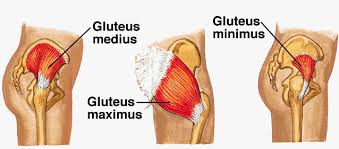
For many years, that question has been a stalwart presence in the national psyche. But more recently, there has been a paradigm shift towards developing the all too neglected buttock muscles.
The main buttock muscles are the Gluteals; Gluteus Minimus, Gluteus Medius and Gluteus Maximus. These muscles are of vital importance to the biomechanics of a well-functioning body.
The Gluteal muscles are, amongst others, responsible for abducting, adducting, internally rotating, externally rotating and extending the hip – pretty much everything you need for walking! They are also one of the main muscles used for generating power when running.
When doing exercise, people tend to favour using the muscles at the front of the leg, such as the quadriceps muscles, over the glutes. Over-use of the quads, while neglecting to engage the glutes, can lead to a muscle imbalance. Over time, the glutes may reduce in size, become harder to activate and not function to their full capacity.
Weak or under-activated glutes can result in numerous aches, pains and injuries that you may not normally associate with them. The following is a list of the more common injuries associated with weak glutes, but are by no means exhaustive;
- Gluteal tendinopathy
- ITB syndrome
- Medial knee pain
- Meniscal injuries
- Lower back pain
- Patello-femoral pain (runner’s knee)
- Plantar fasciitis (heel pain),
- Achilles tendinitis
- Shin splints
- Piriformis syndrome
Boot camps, Cross fit, kettle bell classes and the like – they’re all great for getting stronger and fitter, but sometimes after a prolonged period of neglect the glutes need some isolated attention to remind them of their role. Tailored exercises which improve glute strength and hip stability can be given, depending on the needs of an individual, which can be assessed dramatically improve athletic performance and reduce risk of injury.




